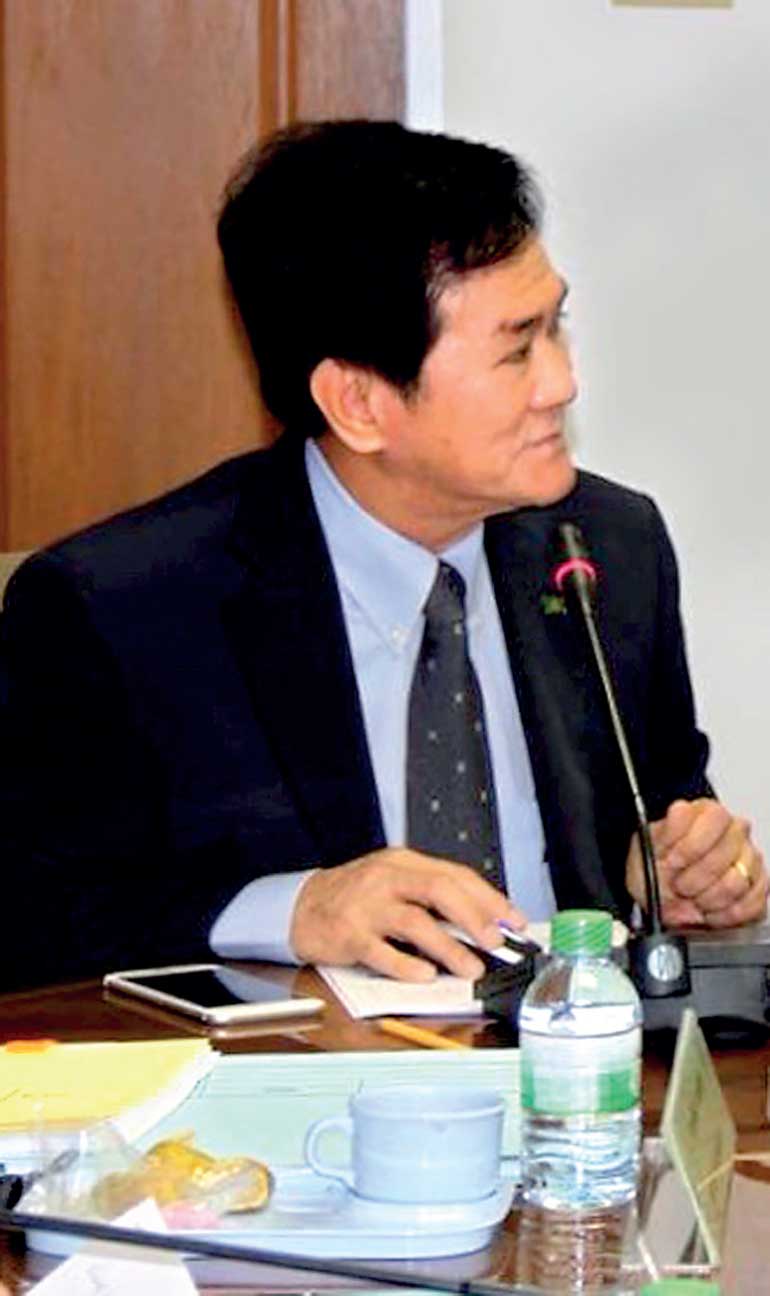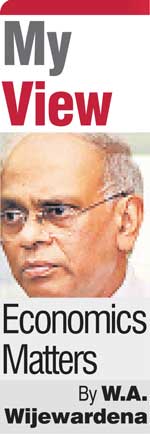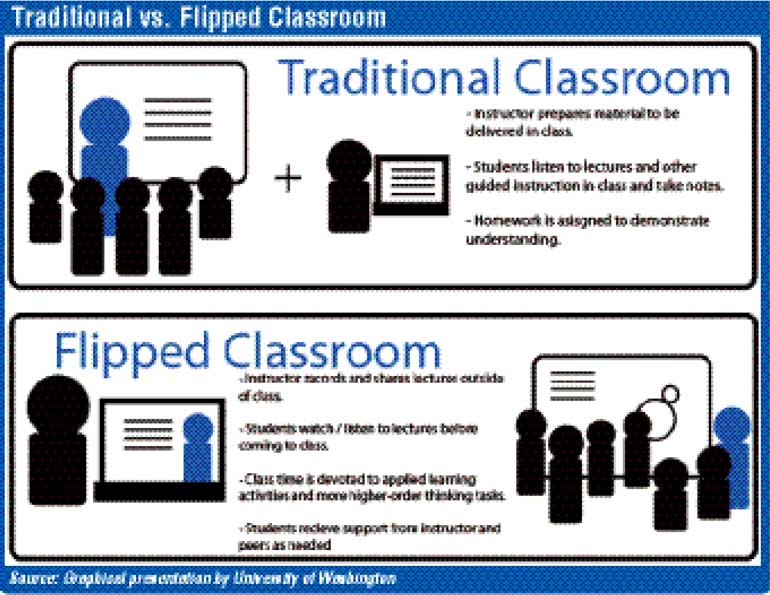Tuesday Mar 04, 2025
Tuesday Mar 04, 2025
Monday, 29 January 2018 00:00 - - {{hitsCtrl.values.hits}}
Two views to groom intellectuals for the 21st century
Two intellectual discourses have recently taken place in Thailand and in Sri Lanka, one month apart from each other, relating to the development of intellectuals in the respective countries for the 21st century.
The first was an address by Professor Worsak Kanok-Nukulchai, President of the Asian Institute of Technology, popularly known as AIT, before the Royal Society of Thailand or RST in December 2017. The title of Worsak’s address was ‘Grooming the Intellectuals to be Global Citizens in the 21st Century’.
The other was a discourse delivered by young and daring media person Chapa Bandara in two sessions, one in the morning and the other in the afternoon, before a group of students reading for a special degree in economics at the University of Sri Jayewardenepura or USJ in January 2018. The theme of Chapa’s multilogue with students was the state of Sri Lanka’s economy today and the future economic strategies to be adopted.
A summary of Worsak’s discourse is presented in his FaceBook page at https://www.facebook.com/search/top/?q=worsak%20kanok-nukulchai . Chapa’s two sessions could be accessed at YouTube at https://www.youtube.com/watch?v=2U9cDEbt3WY&t=3834s and https://www.youtube.com/watch?v=vS9CSft8qxI&t=325s .

Prof Worsak Kanok-Nukulchai addressing Royal Society of Thailand
A common goal for Thailand and Sri Lanka
Both Thailand and Sri Lanka have the same economic goal today. That is to become a rich country within the next generation. Of course, Thailand with a per capita GDP of slightly more than $ 6000 and categorised as an upper middle income country, has started the race much ahead of Sri Lanka. In contrast, Sri Lanka is still at the threshold of joining that group with a per capita income of about $ 3900.
Thailand is fast becoming an industrial powerhouse with about 20% of its manufactured exports representing high-tech exports in 2015 according to World Bank data. The comparable figure for Sri Lanka is a little less than 1%. Hence, the challenge for Thailand is to consolidate its power in the export market. Sri Lanka is just an infant in this trade and, therefore, has to first crawl on knees before starting to walk on its two feet. But, there is a promise for Sri Lanka.
That is due to the inclusiveness of technology, which the futurist Peter Diamandis has called ‘democratisation of digitisation’. Accordingly, an infant today can rise quickly on its feet and start running along with other racers without waiting for so many years to get itself ready for the race.

Framing the educational policy vs. micro treatment of students
The audience addressed by Chapa had consisted of undergraduates at USJ who in the education industry are called ‘throughputs’. A firm in the industry like USJ takes students as throughputs, subjects them to a transformation within the institution during a specified study period and releases those throughputs as ‘intellectuals’ to society.
Hence, the guest lecture arranged by USJ with Chapa is a midway treatment of the throughputs similar to the injection of muscle-growing hormones to broiler chicken by a poultry farmer. In economics, it is called micro-treatment.
In contrast, the discourse of Worsak before RST is to educate those in Thailand who are charged with the task of deciding on the methodology and technology to be used to transform the throughputs to be taken by all the higher educational institutions in the country. Thus, Worsak’s attempt was to enlighten the country’s top policy makers as to how they should frame the future education policy of the country.
In this article, we look at Worsak’s wisdom. In the next one, we look at that of Chapa.
Worsak, the highly qualified engineer turned academic
Worsak became the President of AIT, a position equivalent to that of the Vice Chancellor of USJ, in 2014. He is an engineer who had his undergraduate training at Chulalongkorn University in Thailand. He completed a Master’s degree in engineering at AIT and a doctorate in the same subject at the University of California, Berkley.
Before becoming the President, he had held numerous positions at AIT including the post of the Dean of the School of Engineering (see: https://www.ait.ac.th/about/president/).
Worsak is a fellow member of RST which has a history of close to 100 years. It is the national academy of Thailand that advices the government on academic matters (see:https://ipfs.io/ipfs/QmXoypizjW3Wkn FiJnKLwHCnL72vedxjQkDDP1m XWo6uco/wiki/Royal_ Society_ of_ Thailand.html). Hence, his education of fellow RST members will certainly help Thailand to frame its future education policy to meet the requirements of an emerging era.
From digital natives to global citizens
Worsak has presented the concept of ‘global citizen’, the emerging trend that unifies the peoples of the world. The present young generation, according to him, are ‘digital natives’ who are to evolve into global citizens one day.
Of course, this is not the first attempt or the first tactic used to unify the peoples of the world. As documented by Yuval Noah Harari in his Sapiens: A Brief History of Humankind, there had been three other attempts at unifying peoples of diverse origin and dispersion through money, empires and religion.
The new attempt at doing so has been the modern technology which has created a completely different Homo sapiens. According to Worsak, a gap between the educators and students has arisen in the new digital age ruled by students categorised as digital natives.
Digital natives more inclined to use the web
In his FaceBook page, Worsak has noted: “Many students of current generation, known as “digital natives”, keep wondering why they are expected to take notes in the classroom when they can acquire the same knowledge directly and comprehensively from the web. In fact, some students today are using their mobile phones to search and verify teacher’s contents on the screen. Any university that refuses to recognise and prepare for the reality of change will be out of the business soon.”
It’s challenging to teach digital citizens
This writer has personal experience in what Worsak has noted when he taught students at AIT at the Master’s degree level. Students come to the classroom armed with their mobile devices connected to internet via AIT’s fast WiFi system. It is highly risky for the reputation for the teacher to make a mistake in his presentations because within minutes, a student who has already verified it from the internet would counter him.
Such open countering will help the teacher as well as the students. The teacher has to prepare himself thoroughly before he walks to the classroom not to make any mistake. But mistakes are natural and unavoidable. In those cases, the teacher should have the humility and humbleness to accept his mistake and promote a vibrant interactive class discussion.
In this manner, the teacher will get the opportunity to engage students actively in the learning process. It helps the other students too because by participating in in-class discussions, they would improve their probing, critical and questioning skills, three essential ingredients for becoming an intellectual with creativity.
The entry of the flipped classroom
Learning is a continuous process not necessarily confined only to the classroom. As Worsak had noted elsewhere too, modern learning differs from the traditional learning in which students present themselves in a class before a teacher and rely on the latter to pass wisdom to them. Homework is given to them to ensure their understanding of the subject. Today’s learning starts before the class, gets solidified in the class with interaction with peers and instructors and continues even after the class. This is a blended system of learning which educationists call ‘The Flipped Classroom’.
Preparing the students to face the unknown future
Worsak has elaborated on this point as follows: “Our current education model was introduced since the 19th Century in order to serve the industrial revolution. While the responsibility of teachers was to transmit the knowledge, the responsibility of students was to accumulate knowledge by memorising and taking notes. Upon graduation, they are expected to use and apply the accumulated knowledge for the rest of their life. The same model has continued until today. This model is ill-suited for the digital world of constant change and uncertainties, especially with readily available knowledge on the web”.
He says that today’s challenge for educators is how to prepare the next breed of students in dealing with the ‘unknown future’.

Exponential growth of technology
How would the future be unknown? In his address before RST, Worsak has traced the history of the change in technology and noted that in the current era, technology changes at an exponential rate – a sharp growth moving directly into the sky and into unknown territories.
He says: “I really believe that a more fundamental paradigm change in the education of mankind is necessary. My concern with the current state of higher education has to do with the exponential growth of technology. The ‘digital world’ that we are living today is characterised by disruptive technologies that constantly drive social changes. We will be facing a world of tremendous uncertainties in the years to come. This creates a huge challenge for educators. The exponential growth of technology, with shorter and shorter innovation cycles, will certainly transform every aspect of how we live and work.”
Joseph Schumpeter: Creative destruction is beneficial
It is a different world that we face today, according to Worsak. Old technologies are disrupted by new technologies that take place almost every day.
The Austrian-American economist Joseph Schumpeter called this ‘creative destruction’ in a 1942 book titled ‘Capitalism, Socialism and Democracy’. While disruption is unavoidable, it is essential too for a society to move forward.
Evolution from the slide rule to mobile phone app
Worsak has given a fine example to illustrate this. In 1622, the slide rule was invented and it was the main instrument of use by any engineer to make precise measurements. But by 1970s, the scientific calculator was invented throwing the 350 year old rule of the slide rule to history’s archives.
But the reign of the scientific calculator was confined only to about 30 years. It has now been replaced by the smart phone which can be at the easy access of every student or engineer.
The process of disruption has been explained by Worsak as follows: “Innovative disruption is not new. In the history of mankind, innovative disruptions used to be of a gradual process so their impacts were not felt so much. The only difference now from the past is that the disruption is abrupt and exponential, in time and magnitude, thus carrying much greater impacts to the human lifestyle. For example, the Industrial Revolution has disrupted a big chunk of agricultural process whichever can be mechanised. Likewise, the Digital Revolution has also disrupted the many industrial processes that can be digitised. Soon, we will see the Artificial Intelligence Revolution disrupting and embracing our digital world today”
Disruptive technology: cheaper and more effective
Worsak has also elaborated on the advantages of disruption. Says Worsak: “Any process/product that can be digitised has the advantage of being accessed, reproduced and distributed globally at the speed of internet. This requires much less material and reproducing cost, making it cheaper and affordable to the global mass. Initially, its growth can be deceptively slow but when it reaches the exponential stage, it will suddenly disrupt the previous paradigm due to its better performance in both effectiveness and cost.”
No need to fear new technology
This speed of disruption taking place in the world today is frightening. It has relegated the mankind to an unknown future. Human beings are not wired to accept such abrupt and fast changing worlds as natural. It breeds fear and that fear has been exploited by many to make vulnerable groups ‘intellectual slaves’. Instead of looking at the change in technology with optimism – a powerful weapon to solve emerging problems – those who stand to gain by promoting fear spread stories of ‘pessimism’ going back to history or past nostalgia which cannot be regained today.
What they forget is that time changes in one direction and that direction is forward direction. The case for optimism was elaborated by the futurist Peter Diamandis in a TED lecture in 2012 (available at: https://www.ted.com/talks/peter_diamandis_abundance_is_our_future ). What Diamandis said was that the fear of scarcity is unfounded. The emerging technology can make this world a place of abundance. One has to create a need for it and wait patiently until the next big thing happens in the scientific world.
Worsak’s last piece of advice
According to Worsak, “The contemporary shift in all aspects of life as parts if the globalisation process require that we must nurture our students the so-called ‘Global Component’, to understand and to act on issues of global significance” The responsibility cast on university academics is to help students to merge with the globalisation process seamlessly.
The challenge of university teachers today, says Worsak, is to prepare the students to face the unknown future and help them to transform from digital natives to global citizens.
In the next part, we will examine how Chapa has attempted to do it with students at USJ.
(W A Wijewardena, a former Deputy Governor of the Central Bank of Sri Lanka, can be reached at [email protected] )
Discover Kapruka, the leading online shopping platform in Sri Lanka, where you can conveniently send Gifts and Flowers to your loved ones for any event including Valentine ’s Day. Explore a wide range of popular Shopping Categories on Kapruka, including Toys, Groceries, Electronics, Birthday Cakes, Fruits, Chocolates, Flower Bouquets, Clothing, Watches, Lingerie, Gift Sets and Jewellery. Also if you’re interested in selling with Kapruka, Partner Central by Kapruka is the best solution to start with. Moreover, through Kapruka Global Shop, you can also enjoy the convenience of purchasing products from renowned platforms like Amazon and eBay and have them delivered to Sri Lanka.
Discover Kapruka, the leading online shopping platform in Sri Lanka, where you can conveniently send Gifts and Flowers to your loved ones for any event including Valentine ’s Day. Explore a wide range of popular Shopping Categories on Kapruka, including Toys, Groceries, Electronics, Birthday Cakes, Fruits, Chocolates, Flower Bouquets, Clothing, Watches, Lingerie, Gift Sets and Jewellery. Also if you’re interested in selling with Kapruka, Partner Central by Kapruka is the best solution to start with. Moreover, through Kapruka Global Shop, you can also enjoy the convenience of purchasing products from renowned platforms like Amazon and eBay and have them delivered to Sri Lanka.